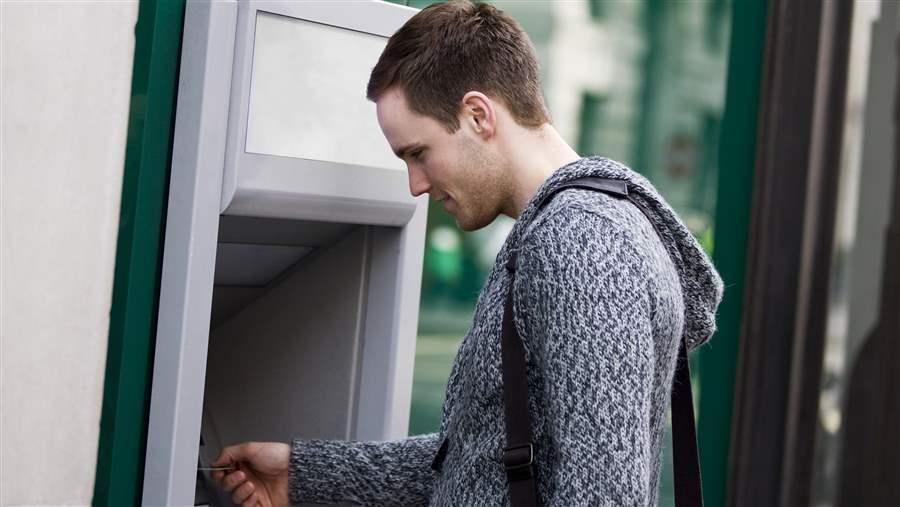Overdraft Facts

This fact sheet examines the relationship between the overdraft policies of 42 of the nation’s 50 largest banks and the revenue those banks earn from overdraft fees. It overlays findings from Pew’s Checks and Balances: 2015 Update with Federal Deposit Insurance Corp. data for the first half of 2015 and demonstrates that bank practices predict both how much revenue these hidden, back-end fees generate and the impact they have on consumers.
Download the fact sheet (PDF).
Overview
Since 2013, The Pew Charitable Trusts has evaluated the overdraft policies and practices of the nation’s largest retail banks, which together hold approximately 66 percent of all domestic deposits in the United States. This research, documented in the Checks and Balances report series, has shown that many of the largest U.S. banks engage in practices that increase costly debit card overdraft fees, although some have voluntarily opted not to do so. Overdraft fees are a major reason that many checking account holders exit the banking system, which reduces their access to lower-cost, mainstream financial services and puts them at greater risk of loss or theft of their funds.
This fact sheet examines the relationship between practices of 42 of the nation’s 50 largest banks and their overdraft fee revenue, as reported in the Federal Deposit Insurance Corp. (FDIC) Reports of Condition and Income (Call Report) and Thrift Financial Report data from the second quarter of 2015, as well as consumer opinions captured in Pew’s Overdrawn report.1
All 42 banks charge insufficient funds fees for overdrafts created by checks and ACH transactions, but banks that also allow ATM and debit card point-of-sale overdrafts reported nearly 400 percent more revenue from overdraft fees than banks that do not.2
- 67 percent of the nation’s largest banks charge $35 to $38 per overdraft.3
- 83 percent of the nation’s largest banks allow ATM and debit point-of-sale overdrafts.4
- These banks reported over $2.4 billion in overdraft fee revenue for the first half of 2015.
Every $1 increase in the disclosed overdraft penalty fee amount is associated with a 6 percent increase in overdraft fee revenue.
- 52 percent of consumers who have paid an overdraft penalty fee for a debit card transaction (“overdrafters”) don’t recall opting in to overdraft coverage.5
- 87 percent of overdrafters are somewhat or very concerned about the cost of overdraft service.6
- 80 percent believe that overdraft practices and fees should be more closely regulated.7
- 68 percent of overdrafters prefer to have their transactions declined rather than pay a $35 overdraft fee.8
- According to the FDIC, 1 in 13 U.S. households (nearly 9.6 million households) is “unbanked”— i.e., does not have a bank account.9
- 31 percent of respondents from unbanked households cited high or unpredictable fees as one reason they do not have accounts, and 13 percent said it was the main reason.10
These findings reinforce the need for the Consumer Financial Protection Bureau to write new rules requiring financial institutions to:
- Make overdraft fees reasonable and proportional to their costs in providing the overdraft loan.
- Post deposits and withdrawals in a fully disclosed, objective, and neutral manner that does not maximize overdraft fees.
- Provide accountholders with clear, comprehensive terms and pricing information for all overdraft options.
Endnotes
- Pew analysis of FDIC Call Report and Thrift Financial Report data from the second quarter of 2015, https://cdr.ffiec.gov/public. Of the 45 banks examined in Checks and Balances: 2015 Update, two were excluded from the analysis because they reported zero dollars in consumer overdraft-related service charges, and one bank listed these charges as “not reported,” as of Aug. 27, 2015.
- A key control variable in the analysis was consumer deposit volume, which served as a proxy for bank size, transactions, and number of accounts. This was calculated as the sum of deposits in noninterest-bearing transaction accounts, interest-bearing transaction accounts, and money market deposit accounts intended primarily for individuals for personal, household, or family use.
- The Pew Charitable Trusts, Checks and Balances: 2015 Update (May 2015), 9, http://www.pewtrusts.org/~/media/Assets/2015/05/Checks_and_Balances_Report_ FINAL.pdf. Twenty-eight of the 42 banks charge $35 to $38 for a single overdraft.
- Ibid, 16. Thirty-five of the 42 banks allow both ATM and debit point-of-sale overdrafts.
- The Pew Charitable Trusts, Overdrawn: Persistent Confusion and Concern About Bank Overdraft Practices (June 2014), 5, http://www.pewtrusts.org/~/media/Assets/2014/06/26/Safe_Checking_Overdraft_Survey _Report.pdf.
- Ibid, 10.
- Ibid, 11.
- Ibid, 12.
- Susan Burhouse et al., 2013 FDIC National Survey of Unbanked and Underbanked Households, Federal Deposit Insurance Corp. (2014), 4, 7, https://www.fdic.gov/householdsurvey/2013report.pdf.
- Ibid, 6.








